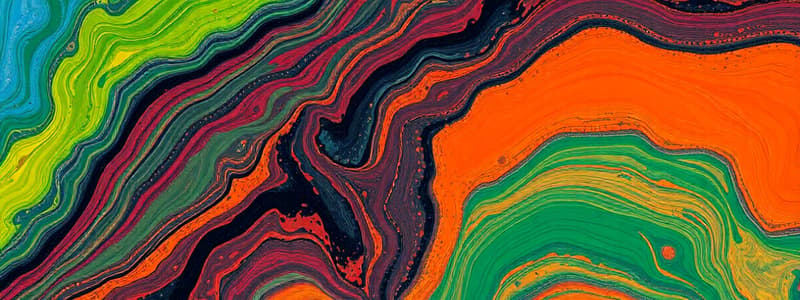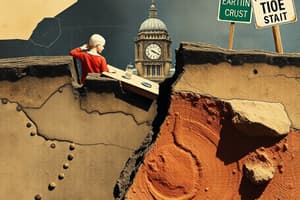Podcast
Questions and Answers
What type of stress occurs when rocks are pulled apart?
What type of stress occurs when rocks are pulled apart?
- Shear
- Tension (correct)
- Compression
- Confining stress
Which type of stress is most common at transform plate boundaries?
Which type of stress is most common at transform plate boundaries?
- Compression
- Shear (correct)
- Confining stress
- Tension
What is the term for a rock's change in shape due to stress?
What is the term for a rock's change in shape due to stress?
- Deformation (correct)
- Confinement
- Compression
- Tension
What type of stress is most common at convergent plate boundaries?
What type of stress is most common at convergent plate boundaries?
When a rock returns to its original shape after stress is removed, it is called:
When a rock returns to its original shape after stress is removed, it is called:
What happens when a rock undergoes fracture?
What happens when a rock undergoes fracture?
What is a simple bend in rock layers called?
What is a simple bend in rock layers called?
What is a fracture in a rock where there is no movement called?
What is a fracture in a rock where there is no movement called?
Which type of fault results from shear stresses?
Which type of fault results from shear stresses?
In what type of fault does the hanging wall drop down relative to the footwall?
In what type of fault does the hanging wall drop down relative to the footwall?
What is a fold that arches upward called?
What is a fold that arches upward called?
What is a fold that bends downward called?
What is a fold that bends downward called?
What type of stress is a deeply buried rock subjected to?
What type of stress is a deeply buried rock subjected to?
In a region that has been deformed, in which layer would you expect to find the oldest sedimentary rock?
In a region that has been deformed, in which layer would you expect to find the oldest sedimentary rock?
Which of the following geologic activities occurs because of plate tectonics:
Which of the following geologic activities occurs because of plate tectonics:
Flashcards
Stress (geological)
Stress (geological)
Force applied to an object.
Confining Stress
Confining Stress
Stress due to the weight of overlying material.
Compression
Compression
Stress that squeezes rocks together, causing folding or fracture.
Tension
Tension
Signup and view all the flashcards
Shear
Shear
Signup and view all the flashcards
Strain/Deformation
Strain/Deformation
Signup and view all the flashcards
Elastic Deformation
Elastic Deformation
Signup and view all the flashcards
Plastic Deformation
Plastic Deformation
Signup and view all the flashcards
Fracture
Fracture
Signup and view all the flashcards
Sedimentary Rock Layer Order.
Sedimentary Rock Layer Order.
Signup and view all the flashcards
Monocline
Monocline
Signup and view all the flashcards
Anticline
Anticline
Signup and view all the flashcards
Syncline
Syncline
Signup and view all the flashcards
Joint (geological)
Joint (geological)
Signup and view all the flashcards
Fault (geological)
Fault (geological)
Signup and view all the flashcards
Study Notes
- Enormous slabs of lithosphere move unevenly, resulting in earthquakes.
- This section considers what happens to rocks when exposed to stress, mountain building and earthquakes.
Causes and Types of Stress
- Stress is the force applied to an object
- In geology, stress measures force per unit area on a rock.
- There are four types of stress that act on materials:
- Confining stress occurs when deeply buried rocks are pushed down by overlying material causing rocks to not deform.
- Compression squeezes rocks, causing folds or fractures and is common at convergent plate boundaries.
- Tension pulls rocks apart, causing them to lengthen or break and is common at divergent plate boundaries.
- Shear stress occurs when forces are parallel but move in opposite directions and is common at transform plate boundaries.
- Strain/Deformation occurs when stress causes a material to change shape, commonly happening in geologically active areas.
- A rock's response to stress depends on the rock type, the temperature, pressure, duration, and type of stress.
- Rocks have three possible responses to increasing stress:
- Elastic deformation allows the rock to return to its original shape after stress removal.
- Plastic deformation means the rock doesn't return to its original shape after stress removal.
- Fracture is the breaking of rock.
Geologic Structures
- Sedimentary rocks help decipher a region's geologic history because they follow rules:
- Sedimentary rocks form with the oldest layers at the bottom and the youngest at the top.
- Sediments are deposited horizontally, like sedimentary rock layers and volcanic rocks (ash falls).
- Sedimentary rock layers that aren't horizontal are deformed, which affect geologic structures like folds, joints, and faults.
Folds
- Folds form when rocks deform plastically under compressive stresses.
- Monocline: A simple bend in rock layers, making them no longer horizontal.
- Anticline: A fold that arches upward, with rocks dipping away from the center, and the oldest rocks in the center.
- Dome: When rocks arch upward in a circular structure.
- Syncline: A fold that bends downward, with the youngest rocks in the center and the oldest on the outside.
- Basin: When rocks bend downward in a circular structure.
Faults
- A rock under enough stress will fracture.
- Joint: A fracture with no movement on either side.
- Fault: A fracture where the blocks of rock move on one or both sides.
- Slip is the movement distance of rocks along a fault.
- The dip (angle) of a fault defines its type:
- Dip-slip fault: The fault's dip is inclined relative to the horizontal.
- Normal fault: The hanging wall drops down relative to the footwall.
- Reverse fault: The footwall drops down relative to the hanging wall.
- Thrust fault: A reverse fault with a nearly horizontal fault plane angle.
- Strike-slip fault: A fault where the dip of the fault plane is vertical, resulting from shear stresses.
- Faults are either right-lateral or left-lateral.
Stress and Mountain Building
- Converging continental plates smash upwards, creating mountain ranges.
- Stress from uplift causes folds, reverse faults, and thrust faults, allowing the crust to rise.
- Subduction of oceanic lithosphere at convergent plate boundaries also builds mountain ranges.
- Tensional stresses pulling the crust apart cause blocks to slide up and down along normal faults, creating alternating mountains and valleys (basin-and-range).
- Horsts: Uplifted blocks that form ranges
- Grabens: Dropped blocks that form basins
Studying That Suits You
Use AI to generate personalized quizzes and flashcards to suit your learning preferences.




